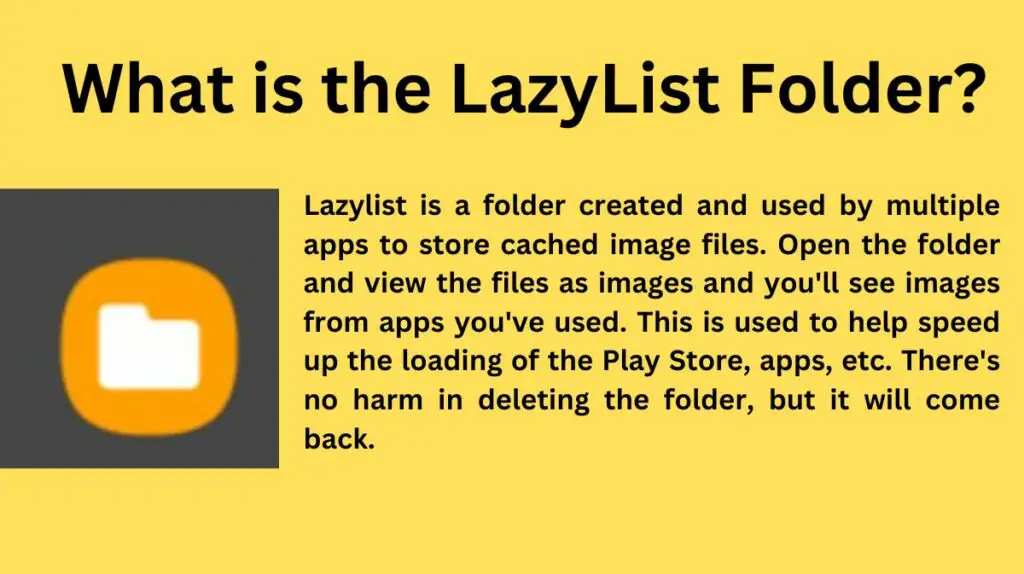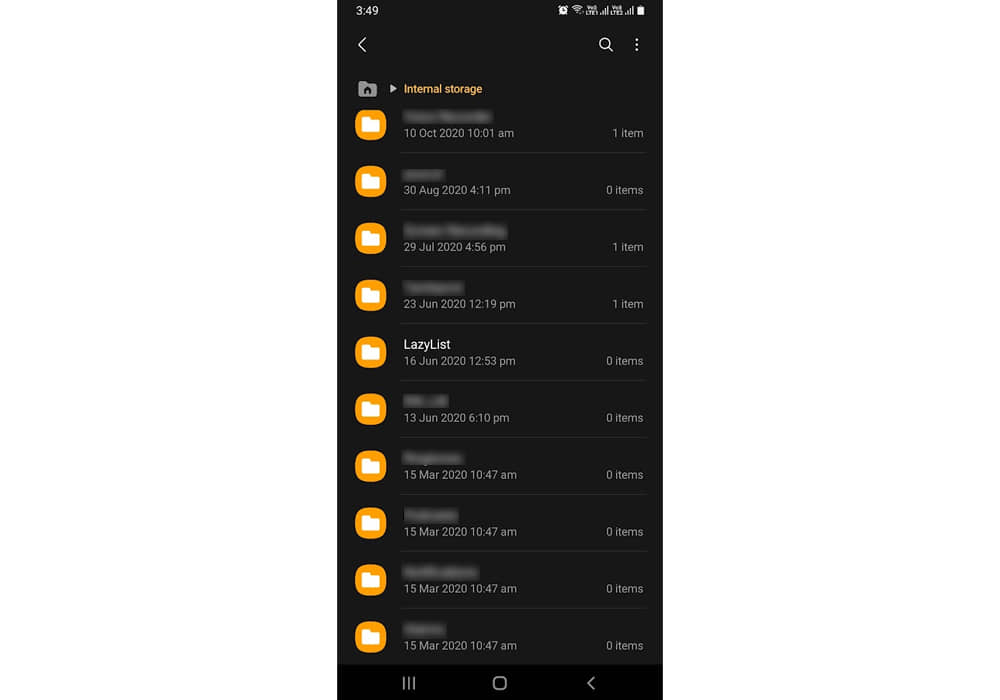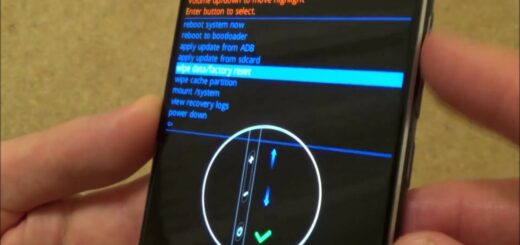What is LazyList Android Folder? Explained
Have you ever come across the term “LazyList Android Folder” and wondered what it is all about? In this blog, we will dive deep into the world of LazyList Android Folder and explore its functions, benefits, and how it affects your Android device.
We will also answer some common questions like whether you should delete the LazyList folder on your Android phone or what happens if someone deletes files on the lazy list. Additionally, we will provide you with step-by-step instructions on how to clean the cache created for LazyList.
So, if you want to understand more about this mysterious folder and how it impacts your Android experience, keep reading!
What is a LazyList Android Folder?
The LazyList Android folder is a directory within an Android application that houses the essential files and code for implementing lazy loading of images. It allows images to be loaded dynamically as they are needed, resulting in improved app performance by reducing initial load time and memory usage.

What is the LazyList Folder in Android?
LazyList is an Android folder specifically designed for storing cached image files. This smart caching mechanism enables apps to access images quickly without repeatedly fetching them from the server. As a result, this functionality proves highly beneficial, allowing apps to load faster, conserve bandwidth, and save mobile data usage.

Functions of LazyList
LazyList serves several essential functions in the context of Android app development:
- Image Caching: LazyList efficiently caches images downloaded from the server to the device’s storage. This caching mechanism helps avoid redundant network requests and speeds up the loading of images in the app.
- Improved App Performance: By storing images locally, LazyList ensures quicker access to cached images, leading to enhanced app performance and a smoother user experience.
- Bandwidth Conservation: Since LazyList retrieves and stores images on the device, it reduces the need for continuous image downloads from the server. This conserves bandwidth and is particularly advantageous for users with limited data plans.
- Data Usage Optimization: With cached images readily available, apps utilizing LazyList can minimize data usage, as images can be loaded from the local storage instead of being fetched repeatedly from the server.
- Offline Access: LazyList facilitates offline access to images that have been previously cached. Users can view these images even without an active internet connection, enhancing the app’s usability in various scenarios.
- Memory Management: LazyList implements memory management techniques to control the size and number of cached images, preventing excessive memory consumption and potential app crashes.
- Reduced Server Load: By reducing the number of image requests to the server, LazyList helps lower the server’s load, contributing to more efficient resource utilization.
Benefits of Keeping the LazyList Folder on Android
Keeping the LazyList folder on Android provides several benefits for both app developers and end-users:
- Faster Image Loading: By caching images in the LazyList folder, subsequent image loading within the app becomes significantly faster. This is because the app can access the locally stored images directly, eliminating the need to download them from the server repeatedly.
- Improved User Experience: Faster image loading translates into a smoother and more responsive user experience. Users can view images quickly without experiencing annoying delays or buffering times.
- Bandwidth Conservation: Cached images in the LazyList folder reduce the amount of data the app needs to fetch from the server. This conserves bandwidth, especially for users on limited data plans or in areas with slow internet connections.
- Reduced Server Load: With cached images readily available on the device, the app sends fewer image requests to the server. Consequently, this eases the server’s load, leading to better performance and reduced strain on backend resources.
- Offline Access: Since images are stored locally in the LazyList folder, users can still access previously cached images even when they are offline or have a poor internet connection. This enhances the app’s usability in scenarios where internet access is limited.
- Minimized Data Usage: By relying on cached images, the app reduces the need for continuous data downloads. This is particularly beneficial for users concerned about data usage or those in regions with expensive data plans.
- Enhanced App Responsiveness: By leveraging cached images, the app’s overall responsiveness improves. The app can allocate more resources to other critical tasks, leading to a smoother and more efficient user experience.
- Improved App Performance: The LazyList folder’s presence contributes to overall app performance improvements. As the app spends less time waiting for images to load, it can execute other functions more quickly and efficiently.
What is a lazylist on an SD card on an Android?
A lazylist on an SD card on an Android refers to a specific folder structure used for storing cached images in Android applications. These folders contain image files that are loaded dynamically when needed, resulting in faster loading times. Certain libraries or frameworks used in Android development create the lazylist folder.
Moving data from internal memory to the SD card can enhance phone browser performance by freeing up space on the internal memory, reducing fragmentation, and providing more resources for browser processes. With less burden on the internal memory, the browser can access cached data quickly, resulting in faster page loading times and a smoother browsing experience overall. Consistently using the SD card for data storage helps maintain better long-term performance, contributing to a faster and more responsive phone browser.
Should I delete the Lazylist on an Android phone?
If you find that you have run out of storage space on your Android phone, and the lack of space is causing performance issues, you might consider examining the contents of folders, including the “LazyList” folder if present. In situations where storage is a concern, deleting unnecessary files or data from the internal memory or SD card can help free up space and alleviate performance problems.
However, exercise caution when removing files from unfamiliar folders, as some may be essential for app functionality. It’s crucial to prioritize backing up valuable data before making any deletions. Additionally, consider utilizing tools like Android’s built-in storage management or storage-cleaning apps to identify and remove large or redundant files, ensuring efficient storage usage without risking the stability of your device.
What happens if anyone deletes files on the lazy list?
LazyList serves as a repository where your phone stores images from web pages to enhance web browsing performance. Deleting the LazyList folder can lead to faster web browsing experiences and reduced data consumption. As images from web pages are no longer cached locally, the browser will fetch fresh images directly from the web servers, potentially resulting in faster loading times.
Additionally, since cached images won’t occupy space, it frees up storage, ensuring better device performance and potentially lowering data usage over time. However, users should be mindful that without cached images, repeated visits to web pages may result in slightly longer loading times as images are retrieved anew from the servers. Nevertheless, deleting the LazyList folder can be a strategic approach to optimize web browsing speed and storage efficiency on your phone.
How to clean the cache create for LazyList
To ensure optimal performance and avoid excessive storage usage, it is important to clean the cache folder created by LazyList. The LazyList Android folder serves as a cache folder for efficiently loading and displaying images in Android apps.
Many apps utilize LazyList technology, resulting in folders named “LazyList” on your SD card. Typically, these folders occupy between 70 MB to 2 GB of space on your SD card.
However, you can easily manage this cache by using third-party file management tools with a cleanup function. Regularly clearing this cache is essential because it accumulates a significant amount of unnecessary data during usage, leading to a buildup of trash that needs to be regularly removed.
Is it OK to Delete the LazyList Folder?
Deleting LazyList or Empty folders poses no risks or harm to the applications on your Android device. However, these folders serve as repositories for cache image files of all apps on your phone. When you delete them, the system promptly regenerates the folders. Consequently, it might be more prudent to refrain from deleting them altogether.
Conclusion
In conclusion, the LazyList Android folder is a useful feature that helps optimize storage and enhance performance on your Android device. It serves as a cache for images and files that are frequently accessed, allowing for quicker loading times and a smoother user experience.
Keeping the LazyList folder on your device has several benefits, including improved app performance, reduced data usage, and efficient use of storage space. However, it is important to note that deleting files within the LazyList folder may have consequences, such as slower loading times or missing images in certain apps.
To clean the cache created by the LazyList folder, you can use built-in storage management tools or third-party apps. While it is generally safe to delete empty folders, exercise caution when deleting files within the LazyList folder to avoid any adverse effects on app functionality.



